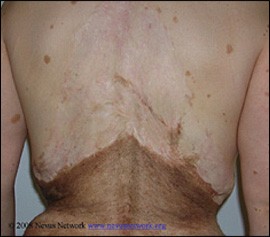
Am Fam Physician. 2009;80(6):554-556
Original Article: Newborn Skin: Part II. Birthmarks
Issue Date: January 1, 2008
Available at: https://www.aafp.org/afp/20080101/56.html
to the editor: In the article on newborn skin, the authors recommend removal of large and giant congenital melanocytic nevi as the current management strategy. In fact, complete nevus removal is impossible for many large nevi and virtually all giant nevi. In these cases, there is an insufficient amount of uninvolved skin necessary for repair after surgical excision, even with the use of multiple, serial skin expanders (Figure 1). Unfortunately, the continued use of this impractical guideline often induces desperation for a cure in both parents and physicians of children with large and giant nevi.
In our congenital nevus support group, many children have undergone 20, 40, or even 60 surgical procedures spanning their entire childhood years in a desperate attempt at removal. This management strategy often is abandoned in the teenage years after the children have been further disfigured by extensive surgical scarring (Figure 2) and finally realize that removal is impossible.

Our support group includes several children who have been diagnosed with post-traumatic stress disorder after undergoing multiple excisional surgical procedures. In our experience, multiple major surgical operations often lead to substantial psychological and emotional trauma. In addition, the risk of severe complications for patients with large/giant nevi is surprisingly low (possibly around 10 percent) over a lifetime. In our support group, the risk of malignancy is currently about 3 to 4 percent for patients with large/giant nevi and about 1 percent for those with smaller nevi such as facial or extremity nevi.1,2 Therefore, there is insufficient reason to perform disfiguring removal procedures in these patients.
The optimal management strategy for children with large/giant nevi is learning to cope with the nevus and its potential health and psychosocial consequences, including the possibility of a shortened lifespan, until better removal techniques are discovered. Fortunately, family physicians are uniquely positioned to assist patients and their families in this potentially daunting task.
in reply: Dr. Bett's letter is a superb reminder why it is crucial for all physicians to understand the distinctions between Strength-of-Recommendation Taxonomy (SORT) grades.1 The expert recommendation for prophylactic removal of large/giant congenital melanocytic nevi (SORT evidence rating: C) has not been supported by well-done clinical trials assessing important outcomes such as disfigurement, psychological stress, pain, transformation to malignancy, death, and quality of life. Family physicians should recommend discussion of surgical options rather than putting the surgical specialist in an awkward position by suggesting surgery is necessary. In our article (Table 1), we slipped into the simplistic “remove nevus” where “discuss removal options” would be more appropriate. We are grateful to Dr. Bett for pointing out how expert opinions need to be treated with caution by referring physicians.